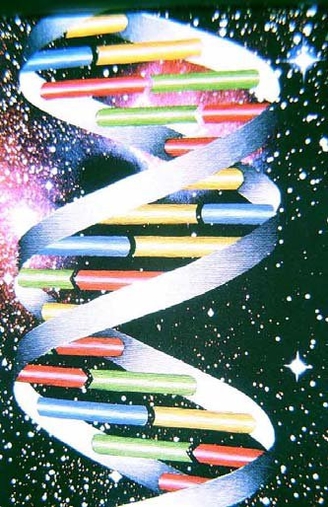 |
 |
 |
 |
 |
 |
 |
 |
|
 |
 |
 |
34 DNA (Desoxyribonucleic Acid)
|
| Menu | back |
In 1953, Francis Crick and James Watson were successful in deriving a model of the three-dimensional structure of genetic material on the basis of X-ray diffraction data from Rosalind Franklin and Maurice Wilkins. Since this discovery, it has been clear that life is not possible without DNA. On the other hand, it also means that if these proteins did not exist previously, which is generally assumed today, the DNA must have developed by chance under primordial soup conditions without an auxiliary matrix. Laboratory experiments show sobering results. Such a scenario is not possible.
|
 |
|
Chemically, DNA is nothing more than an extremely long molecular chain (polymer) consisting of three different types of building blocks: sugar molecules, nitrogen bases (nucleo bases) and phosphorus. Various problems already exist for the creation of these building blocks. DNA contains a specific type of sugar called D-ribose. The main problems with the chemical development of this compound are its short half life, only forty-four years, which is much too short by geological standards, and its unique three-dimensional structure.
It has been possible to produce two of the four essential nitrogen bases in primordial soup experiments with very low yield (0.5% for adenine and 0.1% for guanine). Cytosin and uracil were not available. Moreover, their life expectancy is also much too short. Even if the history of the genesis of life were to stretch over many billions of years, it is unimaginable that the substances required to build DNA would ever converge simultaneously and in purified form.
A further constituent of the DNA structure is phosphoric acid. Although phosphorus is present on the Earth, it is available only in the form of minerals with extremely low solubility (apatite and phosphorite). In this form, it would be impossible for phosphorus to contribute to the formation of a DNA chain molecule.
|
Conclusion:
Neither a sugar molecule, the four nitrogen bases nor phosphoric acid could evolve by themselves under natural conditions in forms practical for production of DNA (1). The associated question regarding the possibility of the synthesis of a DNA chain molecule from these molecules is therefore completely superfluous. Moreover, experience from polymer chemistry shows that it is not possible for DNA to evolve spontaneously without an auxiliary matrix (as is offered by a cell), even when all building blocks are present.
These 35 | Menu |
back
|
Reference:
|
| (1) |
Junker und Scherer, Evolution, ein kritisches Lehrbuch, Weyel, 2006, pages 104114. | |
| |
| (Image) http://www.0095.info/resources/index_fragenundantworten_danksagung2.pdf |
| |
Comment this Site!
|
 |
 |
 |
 |
|

